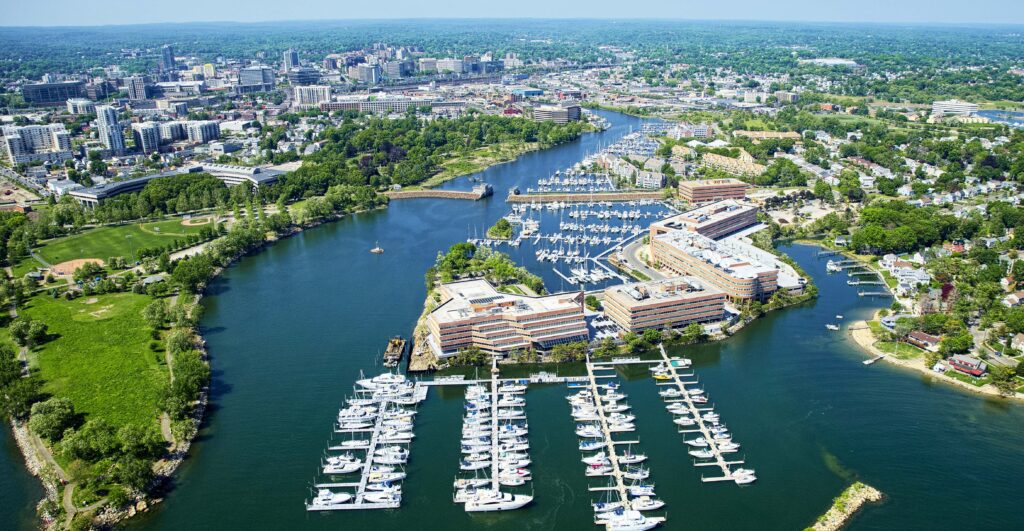 A Look into the Past and Present of This Adorable Connecticut Town
A Look into the Past and Present of This Adorable Connecticut Town
Stamford, Connecticut, is a charming city on the Long Island Sound in Fairfield County. Known as the “Lock City” because of its history as a hub for manufacturing locks, the town has evolved into a thriving and diverse community with a rich cultural scene, beautiful parks, and exciting attractions.
With its proximity to New York City, it has become a popular destination for tourists and residents who appreciate its small-town charm and big-city amenities. If interested in exploring the great outdoors or experiencing the arts and culture, it offers something for everyone. It’s a vibrant and bustling city in the southwestern part of the state and a place to spend a weekender getaway from NYC.

Here are some of the things you can do and see in Stamford that make it awesome:
- Cove Island Park: This park is a beautiful 83-acre oasis on the Long Island Sound. It has a walking trail, a beach, a marina, and a playground, making it the perfect place for a family day out.
- The Stamford Museum & Nature Center: This museum and nature center is dedicated to exploring the wonders of nature and the history of the town. It has a planetarium, a farm, and a wildlife sanctuary home to various animals, including wolves, otters, and birds of prey.
- The Palace Theatre: This historic theater is one of Stamford’s most popular cultural attractions. It hosts a variety of shows, including concerts, plays, and dance performances, throughout the year.
- Mill River Park: This park is located in the heart of downtown Stamford and is a great place to take a stroll, have a picnic, or attend one of the many events there throughout the year.
- Stamford Downtown: The downtown area of Stamford is a hub of activity, with various restaurants, shops, and cultural attractions. It is home to the annual Arts & Crafts Festival, Alive@Five concert series, and the Stamford Downtown Farmers Market.
- Cummings Park: A park located on the shore of Long Island Sound, has a beach, playground, picnic areas, and a boat launch. It is a popular spot for fishing, swimming, and other water activities.
- Stamford Center for the Arts: The cultural center is home to the Stamford Symphony Orchestra, the Connecticut Ballet, and various other performing arts groups. It hosts various events throughout the year, including concerts, dance performances, and theatrical productions.
- Bartlett Arboretum & Gardens: A botanical garden, which is home to various plants, including trees, shrubs, and flowers. It is a beautiful and peaceful place to walk or enjoy a picnic.
- Stamford Public Library: This public library is a great place to spend a quiet afternoon reading, studying, or attending one of the many events and programs there. It also has an extensive collection of books, magazines, and other resources.
- The Ferguson Library: Another great library in Stamford, the Ferguson Library is known for its extensive collection of books and its wide range of events and programs for children and adults.
 Did you know?
Did you know?
Stamford, CT is the birthplace of America’s first-ever public library. In 1881, the Stamford Free Public Library opened its doors to the public, making it the first free public library in the United States. The library was established with the help of a $10,000 donation from philanthropist Andrew Carnegie, who believed that access to free books and education was essential for a thriving democracy.
Today, the town’s library system has two main branches, the Public Library and the Ferguson Library, which serve the diverse community of Stamford and continue to provide free access to books and other resources.
A little history:
Stamford dates back to the 1600s. The area now Stamford was initially inhabited by Native American tribes, including the Siwanoy and the Wappinger. In 1640, a group of settlers from Wethersfield, Connecticut, purchased the land from the Siwanoy and established the town of Stamford.
 The hamlet was primarily an agricultural community in its early years, with farms and mills playing a vital role in the town’s economy. In the 19th century, Stamford became known for its manufacturing industry, particularly the production of locks, earning it the nickname “Lock City.”
The hamlet was primarily an agricultural community in its early years, with farms and mills playing a vital role in the town’s economy. In the 19th century, Stamford became known for its manufacturing industry, particularly the production of locks, earning it the nickname “Lock City.”
During the 1900s, it experienced significant growth and development, with the expansion of its industrial base and the arrival of new businesses and residents. In the 1950s and 60s, many large corporations, including IBM and Xerox, established headquarters, further cementing the city’s status as a significant business hub.
In recent years, the town has continued to evolve and grow, focusing on revitalizing its downtown area, promoting its cultural and natural attractions, and enhancing its quality of life for residents and visitors alike.


